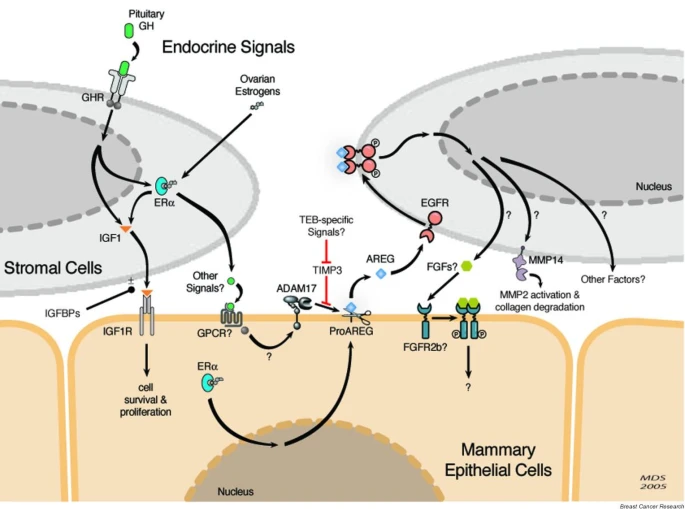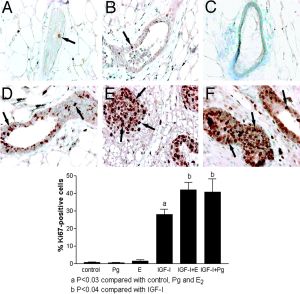
While sex hormones create a blueprint for how cells should develop, there are other substances which are responsible for promoting the differentiation and proliferation of cells in breast tissue.
Provisional model depicting some of the key endocrine and paracrine signals that regulate mammary branching morphogenesis. ADAM, a disintegrin and metalloproteinase; AREG, amphiregulin; EGFR, epidermal growth factor receptor; ER, estrogen receptor; FGF, fibroblast growth factor; FGFR, FGF receptor; GH, growth hormone; GHR, GH receptor; IGF, insulin-like growth factor; IGF1R, IGF-1 receptor; IGFBPs, IGF-binding proteins; MMP, matrix metalloproteinase; TEB, terminal end bud; TIMP, tissue inhibitor of metalloproteinases.
Progesterone
Progesterone is a necessary part of normal breast development in cis women during puberty and has special receptors in breast tissue that respond to it.[1]. Pg was mostly responsible for duct growth and branching. Unlike E2, Pg does not enhance the action of IGF-I on TEB formation or cause ductal decorations. Therefore, there are differences in actions of E2 and Pg on mammary development. Pg has more of an effect on duct formation, extension, and branching, whereas E2 has more of an effect on TEB and more mature alveolar structures.[2]
The changes in hormonal activity over the menstrual cycle may also impact the types of lobules observed within the breast, as Type I lobules have been shown to be more abundant during the follicular phase (when E is relatively high) of the menstrual cycle, whereas Type II lobules are more common during the luteal phase (when P is relatively high).[3]
Trans women typically take 100-200mg of progesterone once daily, preferably as an anal suppository which significantly improves bioavailability.[4]
Ductal Branching
Estrogen and progesterone have some differential effects on parts of breast tissue like the ducts and lobules.
https://www.ncbi.nlm.nih.gov/pmc/articles/PMC5488158/
https://academic.oup.com/endo/article/146/3/1170/2500345
https://www.ncbi.nlm.nih.gov/pmc/articles/PMC4596764/
Relative Estrogen vs. Progesterone Levels
Some research shows that tissue growth is most affected during the luteal phase of menstrual cycle when estrogen levels are low and progesterone is high.[5]
Other studies show that E can have different effects on cells depending on if it's at a low or high level.
Estrone (E1)
Does not appear to have effect on breast growth
https://pubmed.ncbi.nlm.nih.gov/34632510/
Insuling-like Growth Factor (IGF)
IGF is global and tissue-specific growth factor which promotes somatic cell growth and proliferation, including in breast tissue.

https://academic.oup.com/endo/article-abstract/136/3/1296/2497870
https://link.springer.com/article/10.1023/A:1005998832636
https://molecular-cancer.biomedcentral.com/articles/10.1186/s12943-015-0291-7
https://link.springer.com/article/10.1007/s10911-008-9103-7
https://www.ncbi.nlm.nih.gov/pmc/articles/PMC2999497/
https://link.springer.com/article/10.1023/A:1026373513521
Increasing IGF
Natural ways of increasing IGF are to do endurance (cardio) and resistance (weight, rubber bands, etc) training[6][7]. The response to muscle recovery helps increase the levels of growth in your body which will promote breast tissue as well. It's also important to eat a sufficient amount of protein (most people eat a lot less than they need to), especially casein such as in dairy products.[8]
Here is a post from Dr. Powers talking about this https://www.reddit.com/r/DrWillPowers/comments/z317tl/im_fairly_confident_at_this_point_that_diet_and/
It's also possible to increase your IGF by increasing DHEA[9] through supplements but this has downstream hormonal effects which require testosterone and DHT blocking.
Luteinizing Hormone (LH)
Affects some breast tissue cells as part of puberty and in pregnancy
https://www.fertstert.org/article/S0015-0282(09)01228-X/fulltext
https://onlinelibrary.wiley.com/doi/10.1111/j.1442-2042.1998.tb00367.x
Human Chorionic Gonadotropin Hormone (hCG)
Creates tertiary branching which is unique to it, binds to same receptor as LH
https://www.ncbi.nlm.nih.gov/pmc/articles/PMC2783498/
Prolactin
Prolactin has a wide variety of effects. It stimulates the mammary glands to produce milk (lactation): increased serum concentrations of prolactin during pregnancy cause enlargement of the mammary glands and prepare for milk production, which normally starts when levels of progesterone fall by the end of pregnancy and a suckling stimulus is present.
https://link.springer.com/article/10.1023/A:1018708704335
https://www.ejso.com/article/S0748-7983(00)90943-0/fulltext
https://erc.bioscientifica.com/configurable/content/journals$002ferc$002f6$002f3$002f10516853.xml?
Other factors
- Epidermal Growth Factor (EGF)
- Fibroblast Growth Factors (FGFs)
Wnt/β-Catenin Pathway: Involved in stem cell renewal and differentiation in the mammary gland.
Notch Signaling Pathway: Plays a role in cell differentiation and tissue development in the breast.
- ↑ https://www.ncbi.nlm.nih.gov/pmc/articles/PMC8801368/
- ↑ https://academic.oup.com/endo/article/146/3/1170/2500345
- ↑ https://www.ncbi.nlm.nih.gov/pmc/articles/PMC4596764/
- ↑ https://transfemscience.org/articles/oral-p4-low-levels/
- ↑ https://www.ncbi.nlm.nih.gov/pmc/articles/PMC4596764/
- ↑ https://www.frontiersin.org/articles/10.3389/fendo.2021.708421/full
- ↑ https://journals.humankinetics.com/view/journals/jpah/17/5/article-p575.xml
- ↑ https://www.nature.com/articles/ejcn200934#:~:text=Whey%20protein%20stimulates%20fasting%20insulin,growth%2Dstimulating%20effect%20of%20milk
- ↑ https://pubmed.ncbi.nlm.nih.gov/9876338/